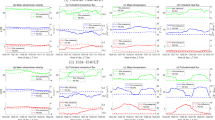Abstract
A version of the two-flow radiative transfer model is presented as a simple method to study the relationship between substances in water and the backscattered radiation field. It is shown that under the assumption of a diffuse radiative input into a water body, the irradiance attenuation coefficient k can be regarded as an inherent property. A cuvette system is presented which allows one to measure and calculate the attenuation coefficient k, the absorption coefficient a and the backscattering coefficient Bb of various substances. The model can be used to check the applicability of a remote sensing technique for a specific research area and for specific parameters, and to estimate the expected accuracy, and the signal depth. The inversion of the model can be applied as a technique to estimate concentrations in water from the backscattered radiation. The critical assumption of a diffuse radiative input and transfer, which has to be made when using the model for natural conditions, is discussed.
Similar content being viewed by others
References
Doerffer, R.: 1979, ‘Untersuchungen Über die Verteilung oberflächennaher Substanzen im Elbe-Aestuar mit Hilfe von Fernmeβverfahren’. Arch. Hydrobiol. Suppl. 43, 119–224.
Gordon, H. R. and McCluney, W. R.: 1975, ‘Estimation of the Depth of Sunlight Penetration in the Sea for Remote Sensing’, Appl. Optics 14, 413–416.
Hulbert, E. O.: 1943, ‘Propagation of Radiation in a Scattering and Absorbing Medium’, J. Opt. Soc. Am. 33, 42–45.
Jain, S. C. and Miller, J. R. 1976, ‘Subsurface Water Parameters. Optimization Approach to Their Determination from Remotely-Sensed Water Color Data’, Applied Optics 15, 886–890.
Jain, S. C. and Miller, J. R.: 1977, ‘Algebraic Expression for the Diffuse Irradiance Reflectivity of Water from the Two-Flow Model’, Appl. Optics 16, 202–204.
Jerlov, N. G.: 1968, Optical Oceanography, Elsevier Publishing Company, Amsterdam-London-New York.
Joseph, J.: 1950, ‘Untersuchungen Über Ober- und Unterlichtmessungen im Meere und Über ihren Zusammenhang mit Durchsichtigkeitsmessungen’, Deut. Hydrograph. Z. 3, 324–335.
Morel, A. and Prieur, L.: 1977, ‘Analysis of Variations in Ocean Color’, Limnol. Oceanogr. 22, 709–722.
Neville, R. A. and Gower, J. F. R.: 1977, ‘Passive Remote Sensing of Phytoplankton via Chlorophyll-a Fluorescence’, J. Geophys. Res. 82. 3487–3493.
Ramsey, R. C.: 1968, ‘Study of Remote Measurement of Ocean Color’, Final Report TRW, NASW-1658, 89 pp.
Smith, R. C.: 1974, ‘Structure of Solar Radiation in the Upper Layers of the Sea’, In N. G. Jerlov and E. Steemann-Nielsen (Eds.), Optical Aspects of Oceanography, 95–119, Academic Press, London, New York.
Schuster, A.: 1905, ‘Radiation through a foggy atmosphere’, Astrophys. J. 21, 1–22.
Author information
Authors and Affiliations
Additional information
The research work was supported by the Deutsche Forschungsgemeinschaft.
Rights and permissions
About this article
Cite this article
Doerffer, R. Applications of a two-flow model for remote sensing of substances in water. Boundary-Layer Meteorol 18, 221–232 (1980). https://doi.org/10.1007/BF00121325
Received:
Issue Date:
DOI: https://doi.org/10.1007/BF00121325




